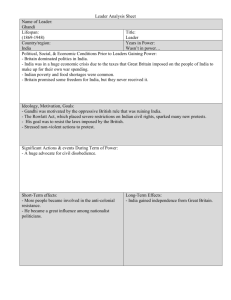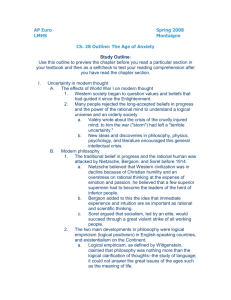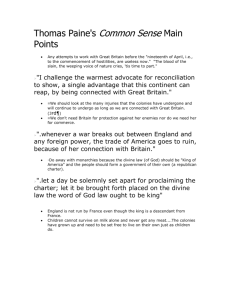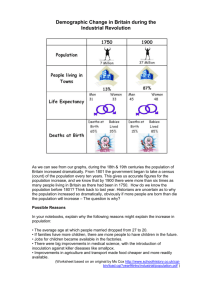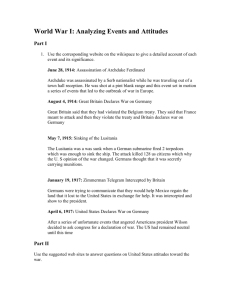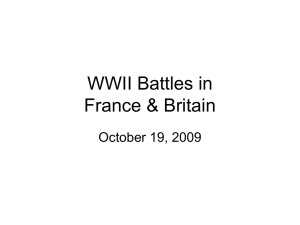The Age of Anxiety
advertisement
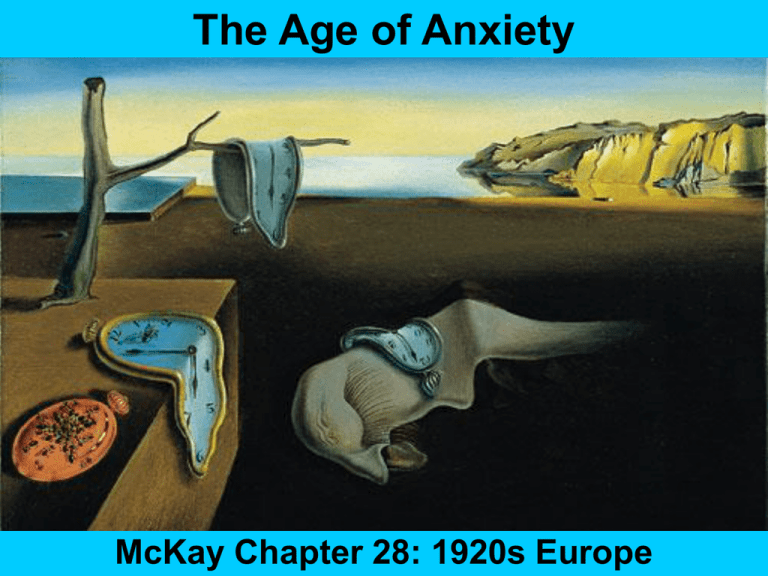
The Age of Anxiety McKay Chapter 28: 1920s Europe Europe in 1919 Uncertainty in modern thought • • Effects of WWI: Intellectual crisis: – In philosophy, psychology, literature, etc. – Questioned liberal beliefs that had guided intellectuals since the Enlightenment • • • Rejected: – progress & reason – existence of a knowable orderly “Newtonian” society Philosophers (writers): – Attacked optimism of pre-1914 – Noted irrational and violent element of human behavior Paul Valéry’s Crisis of the Mind (p. 922): – Wrote about the crisis of the cruelly injured mind – Claimed war ("storm") had left a "terrible uncertainty" Valery is noted for his ruthless and harshly realistic depictions of Weimar society and of the brutality of war Modern philosophy • Traditional belief in progress and the rational human was attacked by Nietzsche, Bergson, and Sorel before 1914 • Friedrich Nietzsche – believed that Western civilization was in decline – Weakened by Christianity – “Slave Morality” which praised humility, the weak – W. Civ overstressed rational thinking at the expense of emotion and passion Nietzsche: “God is dead.” Western Christians no longer really “believed” N. believed that a few superior supermen had to become the leaders of the herd of inferior people Very influential among German radicals (later influenced Hitler) Modern philosophy • Logical empiricism – claimed that philosophy was nothing more than the logical clarification of thoughts, language • Called for – Moral, ethical, religious questions are not "cognitively meaningful" because they can not be proven • could not answer the great issues of the ages such as the meaning of life Ludwig Josef Johann Wittgenstein Existentialism: stressed that humans can overcome the meaninglessness of life by individual action individuals create the meaning and essence of their lives, as opposed to deities or authorities creating it for them Absence of a transcendent force (such as God) means that the individual is entirely free, and, therefore, ultimately responsible. Up to humans to create an ethos of personal responsibility outside any branded belief system •Most famous were French existentialists, Sartre and Camus, who became “big” only after WW II The revival of Christianity • Christianity under attack since Enlightenment • Before WWI theologians tried harmonize religious belief with scientific • A revitalization of fundamental Christianity took place after World War I – Soren Kierkegaard (1813-1855) revived • criticized the worldliness of the church and stressed commitment to a remote and majestic God Karl Barth (1886-1968) stressed the imperfect and sinful nature of man Man can not “reason out” God’s ways T.S. Eliot, C.S. Lewis & other literary figures were caught in in revival Graham Green “One began to believe in heaven because one believed in hell.” The new physics • Pre-1920 physics was based on a Newtonian weltanschauung – World machine – Planck and Einstein undermined belief in constant natural laws • Plank – work with subatomic energy showed that atoms were not the basic building blocks of nature • Einstein – E=MC2 Prof. Albert – postulated that time and space Einstein, are relative » They can be altered (curved) Princeton U. with energy » the universe is infinite – matter and energy are interchangeable Rutherford: Atom was not smallest, solid matter Identified subatomic particles (neutron) new physics instead of Newton's rational laws, there are only tendencies The world was not a perfect predictable harmonious machine!!!! Freudian psychology • Prior to Freud, it was assumed that the conscious mind processed experiences in a rational and logical way. • According to Freud, human behavior is basically irrational. – The key to understanding the mind is the irrational unconscious (the id), which is driven by sexual, aggressive, and pleasure seeking desires. Freud: Behavior is a compromise between the needs of the id and the rationalizing conscious (the ego), which mediates what a person can do, and ingrained moral values (the superego), which tell what a person should do. Instinctual drives can easily overwhelm the control mechanisms; yet rational thinking and traditional moral values can cripple people with guilt and neuroses. Many interpreted Freudian thought as an encouragement of an uninhibited sex life. “Sometimes a cigar is just a cigar.” Twentieth century literature • The postwar moods of pessimism, relativism, and alienation influenced novelists. • Literature focused on the complexity and irrationality of the human mind • Writers such as Proust embraced psychological relativity--the attempt to understand oneself by looking at one's past • Novelists such as Woolf, Faulkner, and Joyce adopted the stream-of-consciousness technique, in which ideas and emotions from different time periods bubble up randomly • Some literature, such as that of Spengler, Kafka, and Orwell, was anti-utopia--it predicted a future of doom. Modern painting • French impressionism replaced with to nonrepresentational expressionism – sought to portray the worlds of emotion and imagination – Van Gogh, Gauguin, Cézanne, and Matisse Vincent van Gogh Starry Night 1889 Paul Gauguin Tahitian Women [On the Beach]) 1891 Themes in Early Modern Art 1. Uncertainty/insecurity. 2. Disillusionment. 3. The subconscious. 4. Overt sexuality. 5. Violence & savagery. Edvard Munch: The Scream (1893) Expressionism Using bright colors to express a particular emotion. Franz Marc: Animal Destinies (1913) Gustav Klimt: Judith I (1901) Secessionists Disrupt the conservative values of Viennese society. Obsessed with the self. Man is a sexual being, leaning toward despair. Gustav Klimt: The Kiss (1907-8) Georges Braque: Violin & Candlestick (1910) CUBISM The subject matter is broken down, analyzed, and reassembled in abstract form. Cezanne The artist should treat nature in terms of the cylinder, the sphere, and the cone. Georges Braque: Woman with a Guitar (1913) Pablo Picasso: Les Demoiselles d’Avignon (1907) Picasso: Studio with Plaster Head (1925) Pablo Picasso: Guernica (1937) George Grosz Grey Day (1921) DaDa Ridiculed contemporary culture & traditional art forms. The collapse during WW I of social and moral values. Nihilistic. George Grosz The Pillars of Society (1926) Raoul Hausmann: ABCD (1924-25) Marcel Duchamp: Fountain (1917) Marcel Duchamp: Nude Descending a Staircase (1912) Salvador Dali: Soft Construction with Boiled Beans (Premonition of Civil War), 1936 Surrealism Late 1920s-1940s. Came from the nihilistic genre of DaDa. Influenced by Feud’s theories on psychoanalysis and the subconscious. Confusing & startling images like those in dreams. Salvador Dali: The Persistence of Memory (1931) Salvador Dali: The Apparition of the Face and Fruit Dish on a Beach (1938) Salvador Dali: Geopoliticus Child Watching the Birth of a New Man (1943) Walter Gropius: Bauhaus Building (1928) Bauhaus A utopian quality. Based on the ideals of simplified forms and unadorned functionalism. The belief that the machine economy could deliver elegantly designed items for the masses. Used techniques & materials employed especially in industrial fabrication & manufacture steel, concrete, chrome, glass. Walter Gropius: Lincoln, MA house (1938) Charlie Chaplin “The Tramp” Movies and radio • • • The general public embraced movies and radio enthusiastically. The movie factories and stars such as Mary Pickford, Lillian Gish, Douglas Fairbanks, Rudolph Valentino, and Charlie Chaplin created a new medium and a new culture. Movie going became a form of escapism and the main entertainment of the masses. Radio, which became possible with Marconi's "wireless" communication and the development of the vacuum tube, permitted transmission of speech and music, but major broadcasting did not begin until 1920. Then every country established national broadcasting networks; by the late 1930s, three of four households in Britain and Germany had a radio. Dictators and presidents used the radio for political propaganda. Movies also became tools of indoctrination In Germany, Leni Riefenstahl’s Triumph of the Will propaganda film for Hitler The Mass Media The search for peace and political stability • • The search for peace was difficult: Germany hated the Treaty of Versailles, France was fearful and isolated, Britain was undependable, and the United States was not interested. Besides, Eastern Europe was in ferment and the international economy was disrupted and poor. Yet, from 1925 to late 1929, it appeared that peace and stability were within reach. But the collapse of the 1930s ended that quest. • Germany and the Western powers Germany was the key to lasting peace, and the Germans hated the Treaty of Versailles. • France believed that an economically weak Germany was necessary for its security and wanted massive reparations to repair devastated northern France. • Britain needed a prosperous Germany in order to maintain the British economy. – J. M. Keynes, an economist, argued that the Versailles treaty crippled the European economy and needed revision. – His attack on the treaty contributed to guilt feelings about Germany in Britain. – As a result, France and Britain drifted apart. Germany and the Western powers • When Germany refused to continue its heavy reparations payments, French and Belgian armies occupied the Ruhr (1923). • The Germans stopped work in the factories, and France occupied the German Rhineland; this left many Germans unemployed. – Inflation skyrocketed; prices soared and savings were wiped out. – Resentment and political unrest among the Germans grew; many blamed the Western governments, and some blamed the Jews and communists. • Under Stresemann, Germany agreed to revised reparations payments, and France agreed to re-examine Germany's ability to pay. – Stresemann represented a new compromising mood in both Germany and France. Hope in foreign affairs (1924-1929) • • • • • The Dawes Plan (1924) provided a solution to the reparations problem: the United States lent money to Germany so it could pay France and Britain so they could pay the United States. In 1929, the Young Plan further reduced German reparations. The treaties of Locarno (1925) eased European disputes. – Germany and France accepted their common border. – Britain and Italy agreed to fight either France or Germany if either country invaded the other. Germany joined the League of Nations in 1926. The Kellogg Briand Pact (1928) condemned war, and the signing states agreed to settle international disputes peacefully. Hope in democratic government • The Ruhr crisis saw the emergence of the radical right under Hitler; his beer hall plot failed, but he set out his theories in Mein Kampf. • But after 1923, democracy took root in Germany as the economy boomed. • However, there were sharp political divisions in the country. – The right consisted of nationalists and monarchists. – The communists remained active on the left. – Most working-class people supported the socialist Social Democrats. In France, the democratically elected government rested in the hands of the middleclass oriented moderates, while communists and socialists battled for the support of the workers. Northern France was rebuilt, and Paris became the world's cultural center. Britain's major problem was unemployment, and the government's efforts to ease it led the country gradually toward state sponsored welfare plans. Britain's Labour party, committed to revisionist socialism, replaced the Liberals as the main opposition party to the Conservatives. Labour, under MacDonald, won in 1924 and 1929, yet moved toward socialism gradually. The Great Depression (1929-1939) • • The depression of 1929-1939 was worldwide and long lasting--and it caused many to turn to radical solutions. The economic crisis – The depression began with the American stock market crash (October 1929). • Net investment in factories and farms fell while share prices soared. • Many investors and speculators had bought stocks on margin (paying only a small part of the purchase price and borrowing the rest from their stockbrokers). • When prices started to fall, thousands of people had to sell their shares at once to pay their brokers, and a financial panic started. Financial crisis led to a decline in production, first in the United States and then in Europe, and an unwise turn to protective tariffs. The absence of international leadership and poor national economic policies added to the depression. Mass unemployment: As production decreased, workers lost their jobs and had no money to buy goods, which cut production even more. Mass unemployment also caused great social and psychological problems. The Scandinavian response to Depression • • • Backed by a strong tradition of community cooperation, socialist parties were firmly established in Sweden and Norway by the 1920s. Deficit spending to finance public works and create jobs was used to check unemployment and revive the economy after 1929. Scandinavia's welfare socialism, though it depended on a large bureaucracy and high taxes, offered an appealing middle way between capitalism and communism or fascism in the 1930s. Recovery and reform in Britain and France • • Britain's concentration on its national market aided its economic recovery--so that by 1937 production had grown by 20 percent. Government instability in France prevented recovery and needed reform. – The Socialists, led by Blum, became the strongest party in France, and his Popular Front government attempted New Deal-type reforms. – France was drawn to the brink of civil war, and Blum was forced to resign (1937), leaving the country to drift aimlessly……………………….

